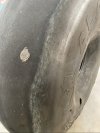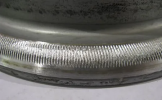I had more than 700-800 hours on my original 26" Goodyears, much of it on pavement. They were wearing down to the bottom of the wear dimples, so I bought a new set and mounted them - I do not know of anyone around here (NC) who has not regretted buying the AKB tires because most of our landings around here are on pavement. We do have grass strips here which I use, but I am based on pavement. My Husky had about 80 hours on it when I bought it in 2006, and had the 8.50s on it. I was planning to fly out west and up to AK (which I did), so I found a set of new 26" GY's which I mounted on a second set of wheels. I have been switching them back and forth since I bought them - summers mostly on the GY's and winters mostly on the 8.50s. I now have over 1500 hours on the airframe and engine, and I just replaced the original 8.50s also (they were well worn) with a set of Michelin 8.50s. So far, so good. I still have the old 26s which I am keeping as spares. The trick with the Goodyears, as Bumper noted, is to do something to keep them from slipping and shearing the valve stem. I used rubber cement on the rims, and do not go below 15 psi if I can avoid it. On primarily pavement, I run more like 18-20 psi on the GYs. If I did all my flying off pavement, I suppose I would like AKBs, but they are significantly more expensive than the GYs and they are much softer rubber. The Goodyears are actually tubeless tires, but I do not know of anyone who has used them that way on a Husky,
I did have tailwheel problems when I first bought the Husky (multiple flat tailwheel tires), probably exacerbated by the fact that it was a Scott. The original springs were at the wrong angle as well. I replaced the tire with a 6 ply, and changed out the tailwheel springs with AKB which eliminated the flat tire problems). I then rebuilt the other stuff with AKB parts over the years as the Scott parts broke. The only Scott part left is the fork...



